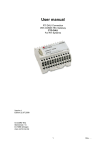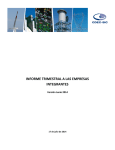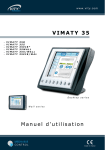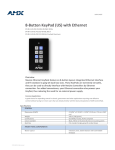Download User manual - COMM-TEC
Transcript
User manual AMX DALI Connection With COMM-TEC Gateway CTG-DALI For AMX – NetLinx Systems Version 1 Edition 01.08.2004 © COMM-TEC Siemensstr. 14 D-73066 Uhingen www.comm-tec.de 1 Rev. … 1.RANGE OF FUNCTIONS CTG-DALI .......................................................................................... 3 2.INDIVIDUAL STEPS FOR SUCCESSFUL INSTALLATION AND ACTIVATION ...................... 4 2.1 Installation And Cabling DALI System .................................................................................. 4 2.2 Installation DALI Gateway ...................................................................................................... 5 2.3 Installation RS232 Port ........................................................................................................... 5 2.3.1 Pin Assignment .................................................................................................................. 6 PC.................................................................................................................................................... 6 2.4 Activation Of DALI Devices With CTG-DALI-Grouper ......................................................... 6 2.5 Integration Of AMX Driver Software CTDALI For Netlinx Controller.................................. 7 2.5.1 Files On Your Computer .................................................................................................... 7 2.5.2 Communication With The Module ...................................................................................... 7 2.5.3 SYSTEM_CALLs................................................................................................................ 7 2.5.4 Addressing ......................................................................................................................... 8 2.6 Individual AMX Programming ................................................................................................ 8 2.6.1 Direct Control Of Brightness Value .................................................................................... 9 2.6.2 Access Maximum, Minimum Value .................................................................................. 10 2.6.3 Scene Access................................................................................................................... 10 2.6.4 Relative Dimming ............................................................................................................. 11 2.6.5 Set Scene Value .............................................................................................................. 11 2.6.6 Further Access Options.................................................................................................... 12 2.6.7 Acknowledgements .......................................................................................................... 12 2.6.8 Error Analysis ................................................................................................................... 12 3 FURTHER INFORMATION ........................................................................................................ 13 3.1 What Is DALI? Fundamentals, Figures, Data And Facts ................................................... 13 3.2 COMM-TEC DCC2000 DALI Light And Room Control ....................................................... 14 4. APPENDIX ................................................................................................................................ 16 A. Table 1 - Times................................................................................................................ 16 B. Table 2 – Dimming Values ............................................................................................. 16 C. Sample Program ............................................................................................................. 17 2 Rev. … 1. Range Of Functions CTG-DALI The following functions and performances for DALI systems are available with the use of COMMTEC gateways CTG-DALI for AMX NetLinx systems: DALI function description Addressing of DALI devices (1 system with 64 DALI devices) Configuration threshold values Min/Max, system error value, other threshold values Definition of groups (up to 16 per DALI device) Change of scene values (up to 16 per DALI device) Access of groups, individual devices and broadcast with scene values, relative dimming and absolute value setting Set dimmer speed Set speed for start-up of scenes Access of DALI Min/Max values Analysis of acknowledgements such as lighting error, bus error, error in DALI device Operation via HTML Operation via standard pushbuttons Operation via AMX touch panels CTG-DALI with AMC control and AMX driver software Yes No x x Remarks With CTG-DALI and PC with Windows program CT-DALIGrouper x x x Also possible with CT-DALIGrouper x x x x x x With individual programming x 3 Rev. … 2. Individual Steps For Successful Installation And Activation Installation and activation of all hardware and software components takes place in 6 steps: 1) Installation and cabling DALI system 2) Installation DALI gateway 3) Installation RS232 interface 4) Activation DALI devices and CT-DALI-Grouper 5) Integration of driver software 6) Individual AMX programming Following we defer to the individual steps; not all steps or parts thereof have to be performed by the AMX supplier. However, the tools provided by COMM-TEC allow for this. 2.1 Installation And Cabling DALI System An installation company performs the electrical installation according to the regulations for high voltage current installations. Furthermore, the technical framework, such as the limitation of maximum participants per DALI line or cable length are to be observed. The 2-core DALI control cable can be installed together with the high voltage current installation and is operated with low voltage (22.5V DC via CTG-DALI). For the DALI control cable no additional electrical installation tools, accessories, meters or testers are required. No special data cables have to be used; a common 5x1.5mm2 NYM cable can be used as power supply cable for EVG and data cable for DALI. No polarity has to be observed, each EVG can be accessed individually, no group cabling is necessary (see figure 2.1.1). Fluorescent light Light bulb After installation, the DALI system is addressed and configured, meaning that each DALI device gets its own address. In this way each DALI device can be assigned to max 16 groups. This configuration is made with the PC software CT-DALI-Grouper. The CTGDALI can be integrated without further configuration into an existing DALI system. In this case the installation company has to define the group and scene functions. If the system is not yet configured, go to chapter 2.2. Shutters Figure 2.1.1 4 Rev. … Technical specifications: • • • • • • • • • • • DALI control cables: e.g. 2-core cable 2x1.5mm2 NYM or any control cable Max. 64 DALI devices in one system Max. cable length DALI signal: 300m DALI power supply 22.5V DC Max. voltage drop DALI signal: 2V Max. power consumption DALI system: 250mA Max. distance DALI EVGs to fluorescent lights in separate array: 2m Max. distance DALI devices for phase control to light bulbs or halogen (high voltage/low voltage (power adaptor)): depending on lead resistance Wiring DALI: delta or series connection Communication speed 1200 bits/sec Tolerance of time specification is ±10%. 2.2 Installation DALI Gateway The DALI gateway is mounted on a DIN rail inside the switchgear cabinet. Terminals D+ and Dare connected to DALI bus. The polarity does not have to be observed. Terminals “230V” are connected to mains power supply. SubD9 port (RS232) serves the connection of PC/laptop or AMS control via RS232 port. DALI bus Figure 2.2.1 Note: If using COMM-TEC interface CTG-DALI no control unit to be Mains power supply for CTG-DALI. Additional adaptors are not to be DALI further DALI integrated. DALI via power connected. 230V mains power supply 2.3 Installation RS232 Port The gateway is connected via 5-core cable to serial interface (RS232) of NetLinx master (pin assignment see 2.3.1). CAUTION! No further pins to be connected! The necessary settings of serial AMX interface (baud rate, parity, etc.) are automatically carried out by AMX module. 5 Rev. … 2.3.1 Pin Assignment PC RS232 9-pin SubD male Gateway 9-pin SubD female Pin n.c. 2 3 n.c. 5 n.c. 7 8 n.c. Pin 1 2 3 4 5 6 7 8 9 AMX Controller NI series 9-pin SubD male Pin n.c. 2 3 n.c. 5 n.c. 7 8 n.c. AMX Controller all Description n.c. RxD TxD n.c. GND n.c. CTS RTS n.c. 2.4 Activation Of DALI Devices With CTG-DALI-Grouper All DALI devices connected via DALI bus have got a short address (0-63) ex factory. Thus with DALI activation first addressing has to be performed. For this COMM-TEC provides you with the PC program CTDALI-Grouper. For individual steps please refer to the separate manual. Fluorescent light Interface Light bulb Configuration and activation of DALI system with COMM-TEC PC program CT-DALIGrouper After successful configuration connect serial interface of AMX NetLinx control system to RS232 interface of DALI gateway CTG-DALI (pin assignment see 2.3). Shutters Figure 2.1 6 Rev. … 2.5 Integration of AMX Driver Software CTDALI For Netlinx Controller The supplied CD contains the finished module in compiled runtime version, meaning it is not available as NetLinx source code. It is integrated in your main program after section DEFINE_START (see sample program in appendix). Additionally in section DEFINE_VARIABLE three variables containing status and value messages and defining the number of EVGs for acknowledgements are to be declared. 2.5.1 Files On Your Computer By integrating the supplied SYSTEM_CALLs in the main program control functions on DALI bus are actuated. For enabling the NetLinx Compiler to integrate the SYSTEM_CALLs, these must be copied before use into a folder on hard drive. Into which folder they are to be copied depends on the installation of the AMX software. In standard instillation all SYSTEM_CALLs are stored in folder “C:\Programme\Gemeinsame Dateien\AMX Share\SYCS”. Please copy all *.LIB files there. 2.5.2 Communication With The Module The module demands two addresses – firstly the interface to which the gateway is physically connected, and secondly a virtual interface, via which the complete communication runs. To differentiate, the following terms are used: Physical interface: Virtual interface: DEV vDEV From the program only the virtual interface is accessed, the physical interface only appears in section DEFINE_DEVICE and in access of the module. 2.5.3 SYSTEM_CALLs The package CTDALI1 includes 5 SYSTEM_CALLs to be integrated into the main program for activation. The current acknowledgement values and status messages are available in acknowledgement arrays. 7 Rev. … 2.5.4 Addressing One DALI line can manage up to 64 bus participants, numbered 0-63 in DALI jargon. In the AMX world this numbering is changed, so that no individual participant “0” exists. Furthermore, the groups 1-16 (DALI 0-15) are accessible. The address 0 serves the global addressing of all participants of a line, meaning: Address Description AMX Term DALI 0 1-64 101-116 broadcast, all participants EVG 1-64 groups 1-16 broadcast addresses 0-63 group 0-15 Current brightness values of the maximum 64 addresses can be provided. Error values (lights/EVGs) can be provided. 2.6 Individual AMX Programming If you choose not to use SYSTEM_CALLs, all commands may be triggered in virtual device with SEND_COMMANDs. Both alternatives are given in the examples. Caution: If using the SEND_COMMANDs the command syntax has to be carefully observed. 8 Rev. … 2.6.1 Direct Control Of Brightness Value Brightness values see table 2. SYSTEM_CALL ‘CT_DALI_1_SetAbs_NX’ Meaning of parameters: <virtual DALI address> <DALI address> <brightness value> <speed> (<virtual DALI address>, <DALI address>, <brightness value>, <speed>) - virtual device address, via which the module communicates with the gateway - #0 broadcast #1-64 individual address #101-116 group address - 0-254 (see table 2) - 0-15 (see table 1) Examples: Set all participants of group 3 with maximum speed to maximum value: Set bus participant #14 (DALI address 13!) within 16 seconds from current to 80% (value from table 2): Note: Alternatively, with SEND_COMMANDs the brightness value can be given as a percentage. The value input has to be directly followed by “P”. Set bus participant #14 (DALI address 13!) within 16 seconds from current to 80%: 9 Rev. … 2.6.2 Access Maximum, Minimum Value SYSTEM_CALL ‘CT_DALI_1_SetMax_NX’ (<virtual DALI address>, <DALI address>) (<virtual DALI address>, <DALI address>) SYSTEM_CALL ‘CT_DALI_1_SetMin_NX’ Meaning of parameters: <virtual DALI address> <DALI address> - virtual device address (see above) - #0 broadcast #1-64 individual address #101-116 group address Examples: Set all participant of group 3 to maximum value: Set bus participant #14 (DALI address 13!) to maximum value: 2.6.3 Scene Access Every bus participant can store up to 16 scene values. SYSTEM_CALL ‘CT_DALI_1_Scene_NX’ Meaning of parameters: <virtual DALI address> <DALI address> <value> <speed> (<virtual DALI address>, <DALI address>, <value>, <speed>) - virtual device address (see above) - #0 broadcast #1-64 individual address #101-116 group address - scene number (1-15) - 0-15 (see table 1) Examples: Set all participant of group 3 within 2.8 seconds to scene 15: Set bus participant #14 (DALI address 13!) within 32 seconds to its value for scene 8: 10 Rev. … 2.6.4 Relative Dimming Continuous change of brightness; Please remember: the started dimming process must be ended! Note: these commands for relative dimming do not switch the concerned EVG on or off. SYSTEM_CALL ‘CT_DALI_1_Dimm_NX’ Meaning of parameters: <virtual DALI address> <DALI address> <direction> <speed> (<virtual DALI address>, <DALI address>, <direction>, <speed>) - virtual device address (see above) - #0 broadcast #1-64 individual address #101-116 group address - 1 – brighter; 2 – darker; 0 – stop - 1-15 Examples: Set all participant of group 3 fast brighter: : Stop dimming for bus participant #14 (DALI address 13!): 2.6.5 Set Scene Value Description of EVG with certain value for a certain scene. SYSTEM_CALL ‘CT_DALI_1_Set_Scene_Val_NX’ Meaning of parameters: <virtual DALI address> <DALI address> <value 1> <value 2> (<virtual DALI address>, <DALI address>, <value 1>, <value 2>) - virtual device address (see above) - Caution! Here only individual address valid #1-64 individual address - scene number (1-15) - 0-254 (see table 2) Examples: Set scene value #11 of EVG #23 to 100%: 11 Rev. … 2.6.6 Further Access Options All selectable addresses (0 for broadcast; 1-64 for individual EVGs and 101-116 for the groups) are mapped directly on levels in the module, meaning they can alternatively be controlled via command SEND_LEVEL (see example program). 2.6.7 Acknowledgements With the integration of the module two data fields are created (see example) containing the acknowledgements of EVGs. When activated all values below this threshold and > 0 correspond with the minimum value. The first data field contains the current brightness value of the corresponding EVG; theoretically values between 0 and 254 are possible. Only theoretically, because most DALI electronic ballasts have a minimum value of either 1% (corresponds to value 85) or 3% (corresponds to value 126). The second data field contains possible error messages. The values have the following meaning: -0 -2 - all other values - ok - light fitting error -bus error / error EVG 2.6.8 Error Analysis In the module channel 127 can be switched on for error analysis. The monitor displays plain text messages, which may contain important information. Proceed as follows: - Start a monitor connection to master (serial or via Telnet) - Activate local echo echo on - Activate plain text messages msg on - Activate messages module on [vdvdali,127] Now also all control commands for testing may be input via SEND_COMMANDs (description see above under SYSTEM_CALLs). Example: Set all EVGs immediately to minimum value: Set all EVGs of group 5 to secene value 12 within 2 seconds: Switch off EVG 1 (DALI #0!) immediately: 12 Rev. … 3 Further Information 3.1 What Is DALI? Fundamentals, Figures, Data And Facts DALI stands for “Digital Addressable Lighting Interface” and is the definition for the standardized digital device interface and was created by the manufacturers of these devices. With this standard the compatibility of device of different manufacturers such as Osram, Tridonic, Helvar or Philips in a lighting installation is guaranteed. DALI is not a new system for central building control systems such as LON, EIB or Luxmate but a meaningful addition for practical application of lighting control. The reason: Systems such as EIB and LON are designed for much more complex tasks within the building and are thus more expensive. With the DALI technology innovative, flexible, easy and cost efficient solutions can be put into practice. DALI replaces here the 1-10V control technology of electronic ballasts for lighting (EVG) and will replace them medium-term. Cabling 1-10V for analog EVG 1-10V voltage e.g. fluorescent light Mains power supply Figure 1.1 This can be dropped for DALI compatible devices. Every DALI device still needs 230V power supply, but the electronics for dimming 0-100% a located in the DALI EVG (figure 1.2). Via the digital, bi-directional control with DALI EVGs the actions are actuated right in the DALI device – with this also acknowledgement of devices (e.g. defective light fitting) is possible. To operate a DALI system controls are mandatory. EVGs and other devices such as transformers are mandatory for several illuminants, such as fluorescent lights or halogen lights. For the dimming of fluorescent lights controllable EVGs are mandatory. Until today so-called analog 1-10V EVGs were utilized. Disadvantage: inaccurate control and costly installations. Additionally, analog EVGs with 1-10V control need a switched 230V signal e.g. via a relay for on/off switching (figure 1.1). Cabling DALI-EVG Lighting control fluorescent light Figure 1.2 13 Rev. … DALI provides among others the following functions: • Available DALI actuators: EVGs for fluorescent lights, phase control dimmers, shutter actuators, relays, etc. • Easy cabling of control wire • One DALI system consists of: - max. 64 individual devices - max. 16 groups - max. 16 scenes • Synchronized scene transmissions, meaning all accessed light fittings reach their target brightness at the same time • Groups and scene values are stores in the DALI device • Status display such as light fitting error • Adjustment of threshold values, dimming speed • Emergency power features Further information under: www.dali-ag.org 3.2 COMM-TEC DCC2000 DALI Light And Room Control The comfort controller for up to three DALI systems powered by AMX manages per device up to 3 DALI systems with 64 DALI devices. The system is a compact solution and needs no programming. Additionally, each controller integrates 4 relays for room functions such as shutters and 4 inputs for key control-sections or sensors. The configuration of the DALI system, change of operating settings, scene values etc. takes place via PC web browser and HTML interface via integrated AMX web server. The controls work separately as light and room controls. Several DCC2000 can be networked via Ethernet for buildingwide solutions. System bus Integration of EIB, LON is optional. As control concept a certain number of DALI control unit standard pushbuttons Shutters (32), AMX touch panels (4) or LCD Door openers Light or keypads (4) can be motion sensors employed. Air con Screen DALI world 3 DALI world 2 14 DALI world 1 with up to 64 DALI devices Rev. … The following functions and features for DALI systems are available with the COMM-TEC DCC2000 DALI light and room control: DALI function Addressing of DALI devices (up to 3 systems with 64 DALI devices each) Configuration threshold values Min/Max, system error value, other threshold values Definition of groups (up to 16 per DALI device) Change of scene values (up to 16 per DALI device) Access of groups, individual devices and broadcast with scene values, relative dimming and absolute value setting Dimmer speed setting Scene value speed setting Access of DALI Min/Max values Analysis of acknowledgements such as light fitting errors, bus errors, errors DALI device HTML configuration and operator page Operation via HTML Operation via standard pushbuttons Operation via AMX touch panels DCC2000 Yes No x Remark x x x For the function setting not programming is necessary. This is included in the DCC2000 software. Configuration via Ethernet (PC) with HTML pages of DCC2000 DALI controller (web server integrated). x x x x x x x x x 15 Rev. … 4. Appendix A. Table 1 - Times Times for the setting of absolute values or scenes Value 0 1 2 3 4 5 6 7 8 9 10 11 12 13 14 15 Duration < 0.7 sec 0.7 sec 1.0 sec 1.4 sec 2.0 sec 2.8 sec 4.0 sec 5.6 sec 8.0 sec 11.3 sec 16.0 sec 22.6 sec 32.0 sec 45.2 sec 64.0 sec 90.5 sec B. Table 2 – Dimming Values Luminous flux Digital dimming value 0% 0.1% 0.5% 1.0% 3% 5% 10% 20% 30% 40% 50% 60% 70% 80% 90% 100% 0 1 60 85 126 144 170 195 210 220 229 235 241 246 250 254 $00 $01 $3C $55 $7E $90 $AA $C3 $D2 $DC $E5 $EB $F1 $F6 $FA $FE 16 Rev. … C. Sample Program Here the gateway is physically connected Communication via this address Number of EVGs Current values Current states Set all EVGs immediately to max. value Set all EVGs immediately to min. value 17 Rev. … - Select duration for setting of scene or absolute value - Select speed for relative dimming Speed 2-10 Set scene Set scene 1 Set scene 2 Group 3 set direct values with selected speed brighter darker 18 Rev. … Set all EVGs via bar graph Text output on panel (for first 10 EVGs) Selected speed / duration 19 Rev. …


































